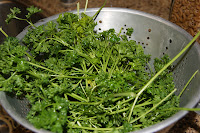After rinsing under cool, running water and shaking to remove excess moisture, place the herbs in a single layer on dehydrator trays. Drying times may vary from 1 to 4 hours. Check periodically. Herbs are dry when they crumble. Here is a step by step
How To Dry Herbs
- Cut healthy branches from your herb plants.
- Remove any dry or diseased leaves
- Shake gently to remove any insects.
- Rinse with cool water and pat dry with paper towels. Wet herbs will mold and rot.
- Clip you herbs off the stems. Place them on the trays. Do not overlap. Follow the instructions in your dehydrator booklet for times.
Storing Dried Herbs
- I use my food saver for those I will not use as often. I also pack them in small quantities. I also like to use small canning jars.
- Be sure to label & date your containers.
- Your herbs will retain more flavor if you store the leaves whole and crush them when you are ready to use them.
- Discard any dried herbs that show the slightest sign of mold.
- Place containers in a cool, dry place away from sunlight.
- Dried herbs are best used within a year. As your herbs lose their color, they are also losing their flavor.
- Use about 1 teaspoon crumbled dried leaves in place of a tablespoon of fresh.
 When the leaves are crispy dry and crumple easily between the
fingers, they are ready to be packaged and stored. Dried leaves may be
left whole and crumpled as used, or coarsely crumpled before storage.
Husks can be removed from seeds by rubbing the seeds between the hands
and blowing away the chaff. Place herbs in airtight containers and store
in a cool, dry, dark area to protect color and fragrance.
When the leaves are crispy dry and crumple easily between the
fingers, they are ready to be packaged and stored. Dried leaves may be
left whole and crumpled as used, or coarsely crumpled before storage.
Husks can be removed from seeds by rubbing the seeds between the hands
and blowing away the chaff. Place herbs in airtight containers and store
in a cool, dry, dark area to protect color and fragrance.Dried herbs are usually 3 to 4 times stronger than the fresh herbs. To substitute dried herbs in a recipe that calls for fresh herbs, use 1/4 to 1/3 of the amount listed in the recipe.

Less Tender Herbs — The more sturdy herbs such as rosemary, sage, thyme, summer savory and parsley are the easiest to dry without a dehydrator. Tie them into small bundles and hang them to air dry. Air drying outdoors is often possible; however, better color and flavor retention usually results from drying indoors.
Tender-Leaf Herbs — Basil, oregano, tarragon, lemon balm and the mints have a high moisture content and will mold if not dried quickly. Try hanging the tender-leaf herbs or those with seeds inside paper bags to dry. Tear or punch holes in the sides of the bag. Suspend a small bunch (large amounts will mold) of herbs in a bag and close the top with a rubber band. Place where air currents will circulate through the bag. Any leaves and seeds that fall off will be caught in the bottom of the bag.


No comments:
Post a Comment
We love to answer your questions and hear from each and every one of you